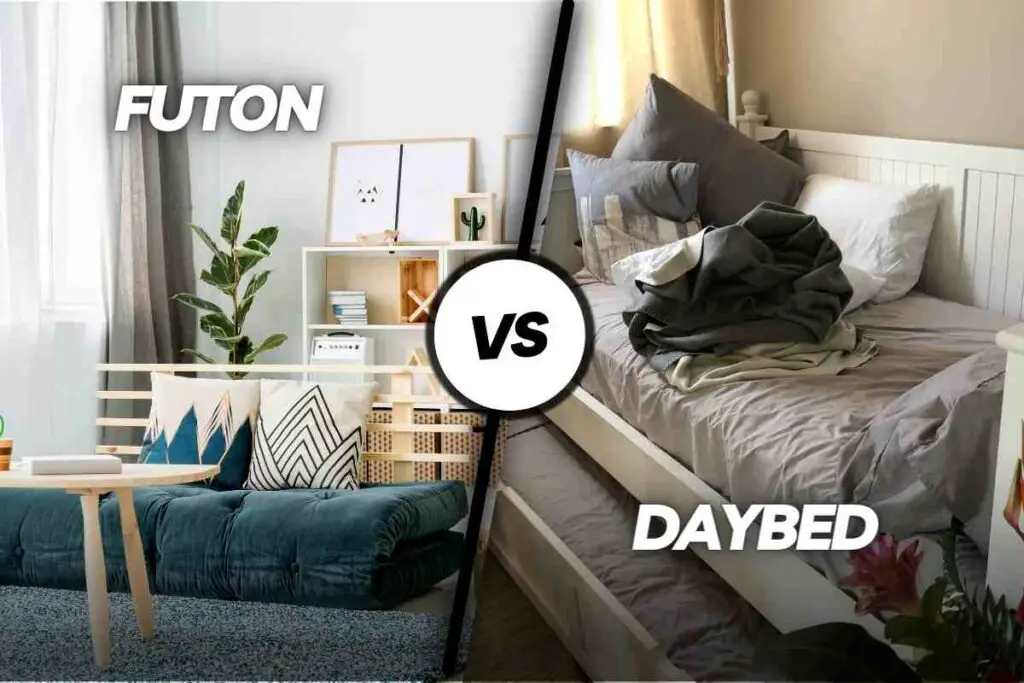Futon vs Daybed: What’s the Difference?
When it comes to finding the perfect piece of furniture for your home, you may be wondering whether to choose a futon or a daybed. Both options offer a comfortable and versatile seating and sleeping solution, but there are a few key differences to consider.
A futon and a daybed are both pieces of furniture that can be used for sitting or sleeping. However, there are some key differences between the two.
A futon is a couch that can be converted into a bed by unfolding the backrest to create a flat sleeping surface. On the other hand, a daybed is a bed with a backrest and a set of arms on either side, making it more like a couch than a traditional bed. Daybeds are typically used as a seating area during the day and as a bed at night.

In this article, we’ll compare futons and daybeds in five key areas to help you decide which option is best for you.
See Also: How to Buy Bedding for a Daybed
Futon vs Daybed: What’s the Difference?
Here are the key differences between Futon vs Daybed:
01. Size
One of the biggest differences between futons and daybeds is size. A futon is typically larger and heavier than a daybed, which can make it more difficult to move around.
This can be a major consideration if you’re limited on space or want a piece of furniture that is easy to move from one room to another. On the other hand, the larger size of a futon also makes it more comfortable to sleep on.
A daybed is typically only big enough for one person, whereas a futon can accommodate two people comfortably. This makes a futon a good option for a guest bed or for small apartments where space is at a premium.
02. Design and style
One of the main differences between futons and daybeds is their design and style. Futons are typically designed with a minimalist aesthetic and are often made of sturdy wooden frames with a mattress that can be folded up to create a sofa-like seating area.
On the other hand, daybeds are more like traditional beds, with a frame and headboard, and are often made of wood or metal.
Daybeds also typically include a trundle bed, a smaller bed that can be pulled out from under the main bed.
03. Functionality
When it comes to functionality, both futons and daybeds offer versatile seating and sleeping solution. However, the main difference is how they transform from one function to another.
With a futon, the mattress can be folded up to create a sofa-like seating area and then pulled out and unfolded to create a bed.
On the other hand, daybeds are designed to be used as both a seating area and a bed without needing to be transformed.
04. Comfort
When it comes to comfort, both futons and daybeds can be comfortable to sit on and sleep on. However, the mattress you choose can greatly affect your comfort level.
Futons are typically made with a thinner, more firm mattress, while daybeds are often thicker and softer. This means that a daybed may be the better option if you prefer a softer and more cushioned sleeping surface.
05. Space-saving capabilities
If you’re looking for a furniture option to help save space in your home, futons and daybeds can be great options. Futons are particularly good at saving space because they can be folded up and stored away when unused.
On the other hand, daybeds can be used as both a seating area and a bed, which means you won’t need to have both a couch and a bed in your living space.
However, daybeds are typically larger than futons, so a futon may be the better option if you have limited space in your home.
Final Thoughts
After carefully considering the features and benefits of both futons and daybeds, it is clear that these two pieces of furniture have their unique strengths and drawbacks.
Futons are versatile and affordable, making them a popular choice for small spaces or people on a budget. They can be easily converted from a couch to a bed, allowing them to serve as a seating and sleeping area. However, some people may find futons uncomfortable to sleep on due to their firmness.
On the other hand, daybeds are more traditionally designed and generally more comfortable to sleep on. They are also a good option for people who want a piece of furniture that can be used as a seating area and a bed.
However, daybeds tend to be more expensive than futons, and they do not have the same level of versatility.
Ultimately, the decision between a futon and a daybed comes from personal preference and individual needs.

